|
What this Blu-ray and DVD release calls the Heroic Age of Antarctic Exploration runs about a quarter-century, beginning right at the end of the nineteenth century and ending in the 1920s, not halted by a World War during that time. This period coincided with the rise of cinema as a public entertainment form. The first surviving motion picture film dates to ten years before the first expedition shown in this set and by then the Lumière Brothers had presented the first showings of moving pictures projected to a screen to an audience larger than a single person watching through a peephole or similar device. By the time of the last expedition in this set, cinema was a medium reaching mass audiences and films of feature length were commonplace. Some of the films here were commercially released to that mass audience.
The emergence of cinema technology was something that didn't escape the notice of the explorers and the people who funded them. While only a select few could visit the polar regions, let alone the South Pole itself – and they would have to be young, physically fit, trained and male, in the latter respect until the 1930s at least – there were potentially millions more who would be fascinated to see moving images of these places, flickering in the light of a projector on a big screen. So an essential part of the crew was the cinematographer and it says something about his importance that, when Sir Ernest Shackleton's ship Endurance had to be abandoned, the film that had been shot was not abandoned with it but was taken away by the crew, even if it meant it took the space of two days' food rations. The most celebrated of these films was South, taken on Shackleton's expedition from 1914 to 1917. The cinematographer on that expedition was Frank Hurley.
Before I continue, the menu of this Blu-ray and DVD release is listed by the expeditions in chronological order. However, this disc highlights South (which, in Hurley's native Australia was called In the Grip of the Polar Pack-Ice) and I'll do the same, with the footage from the other expeditions discussed under "Special Features" below along with the two items which are actually listed as extras.
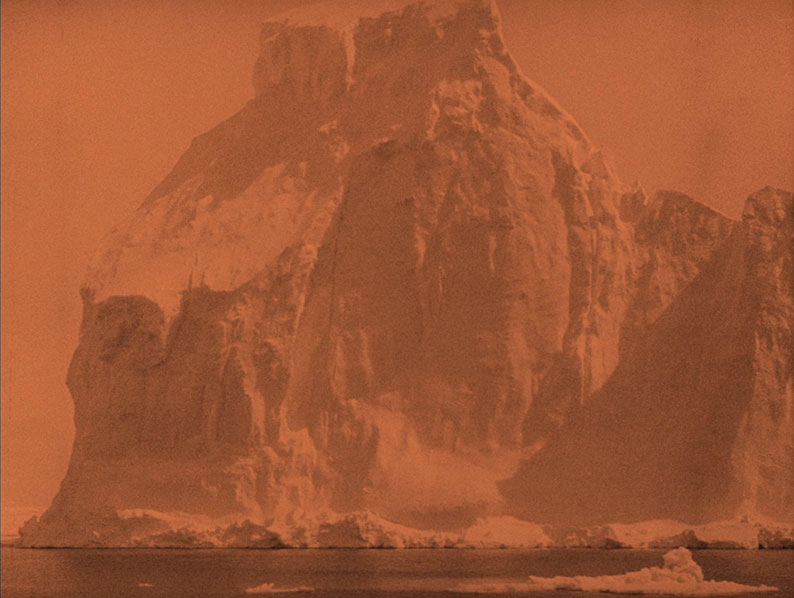
Hurley (1885-1962) had already had experience of the Antarctic. In 1908, he joined the expedition led by Douglas Mawson, which set out in 1911 and returned in 1914. Hurley's footage was edited and became a documentary, The Home of the Blizzard, of which more below. The story has it that Hurley was in Queensland when an aboriginal man approached him, carrying a telegram in a cleft stick. That telegram was Hurley's invitation to join Shackleton's expedition.
By then, Antarctic exploration was of considerable popular interest, which had reached a height in 1911 when two rival expeditions set out to be the first to set foot at the South Pole. The ones which reached 90° South first were a Norwegian crew led by Roald Amundsen, who got there before an expedition led by Robert Falcon Scott. Scott and his men died on their way back from the Pole and that doomed trip has become a byword for heroic failure and tragedy. It's been dramatised more than once – Scott of the Antarctic (1948) was a prestigious British film of its day, Royal Command Performance and all, becoming the third most successful film at the British box office that year. Scott's expedition had a cinematographer to hand, Herbert Ponting, and his documentary record, The Great White Silence, was released in 1924. (The BFI have reissued The Great White Silence as a dual-format release at the same time as South.)
Sir Ernest Shackleton (1874-1922) had also had previous experience of Antarctic exploration. He had been third officer on Scott's expedition in the Discovery of 1901-1904, where they had reached 82°S, the southernmost point then attained. In a subsequent expedition in the Nimrod in 1907-1909, Shackleton reached 88°S, just ninety-seven miles from the Pole. As a result of that voyage, Shackleton was knighted.
A decade later, as the Pole had been conquered by Amundsen and Scott, Shackleton set his sights on a more ambitious goal. The Imperial Trans-Atlantic Expedition would cross the Antarctic ice cap from the Weddell Sea to the Ross Sea, passing through the South Pole on its way. Shackleton's ship Endurance would arrive at the Weddell Sea and then Shackleton and his team of six would set out across the ice. Meanwhile, a second ship, the Aurora, commanded by Captain Aeneas Mackintosh, would sail to the Ross Sea and lay supply depots every sixty nautical miles in a trail across the ice shelf for Shackleton and his men to obtain the food and fuel enabling them to complete their trek.
Endurance left South Georgia on 5 December 1914 but disaster struck on 19 January, when the the ship was stuck fast in an ice floe, with no prospect of its being released until the following spring, in September. The ice put considerable pressure on the ship's hull and with the thawing and the movement of the ice, the hull was breached. Shackleton and his men survived on ice floes, hoping they might drift to the nearest land, and eventually took to lifeboats and after five days at sea landed on Elephant Island.
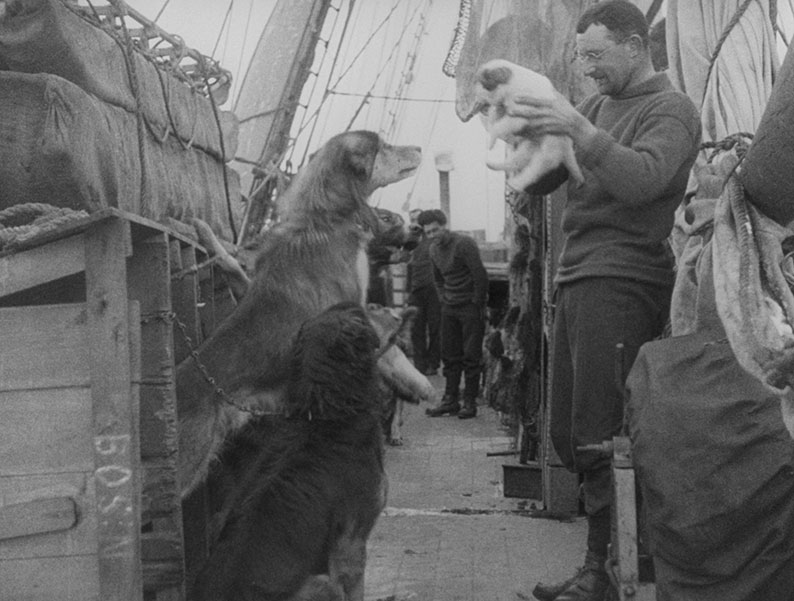
This island was bleak and inhospitable, away from any shipping routes. Shackleton and five others took the largest lifeboat and set off hoping to find rescue, leaving the other men, Hurley included, on Elephant Island. Finally, Shackleton and two of his men reached the uninhabited southern shore of South Georgia, and they trekked over the mountainous and glacial terrain until they reached the whaling settlements on the northern shore. The three men left on the south shore of South Georgia were rescued, and with the help of a Chilean tug, the Yelcho, he travelled back to Elephant Island and rescued the twenty-two men who had been there for four and a half months. Meanwhile, the Aurora had had returned to New Zealand, having carried out its depot-laying mission. Unfortunately three men had lost their lives, Captain Mackintosh among them.
Hurley had filmed on Endurance, up to the point where the ship had been abandoned. His film cans were taken off the ship along with the plates for a selection of his still photographs. The heavy cameras were left behind. After Shackleton returned to England in May 1917, he used Hurley's footage as illustrations in a series of lecture tours. However, to take the film up to feature length, Hurley returned to South Georgia to shoot there, with a particular brief to capture the rare wildlife on film. That, as much as the vast icy landscapes and the human heroics was a particular selling point of the film, released in 1919.
Meanwhile, as World War I was still raging when the men returned, Hurley had enlisted as a war photographer, capturing many images of the Third Battle of Ypres. Later photographs of his were of the building of the Sydney Harbour Bridge (opened in 1932) and, when war broke out again, battles in the Middle East. He died in 1962.
Like many such films, South is a document of its own making. As the expedition had not been the success that was planned and had become a struggle for survival, so the film is a composite: a documentary of the voyage for its first two-thirds, brought up to feature length by travelogue material. We now have the resources to go all over the world and to bring back images (and, given that South was made in the silent era, the sounds as well) of the landscapes and wildlife to be found there. But for an audience just over a hundred years ago all this was new. Especially in this newly-restored form – especially if you get a chance to see it on the big screen – South is still very impressive, both for what it achieved and for the heroism it took for that achievement.
South & The Heroic Age of Antarctic Exploration on Film is a dual-format release from the BFI, comprising one Blu-ray disc and two DVDs. A checkdisc of the former, encoded for Region B only, was received for review. South has a U certificate while the other films, documentaries with nothing likely to receive anything higher than that, exempted from BBFC certification.
Shot on 35mm black and white stock, South has a Blu-ray transfer in the correct ratio of 1.33:1, which is what you would expect for a film from the silent era. It derives from a 4K scan of a 35mm restoration negative and the intertitles and colour tinting recreate what you would have seen back in 1919. The frame rate has been adjusted from the original (most likely eighteen frames per second, but I don't have confirmation of this) to the present-day twenty-four frames per second, by duplicating frames – from 18 fps to 24 fps that would most likely be every third frame – but this is not something you would notice in motion. The results are excellent, with plenty of detail and natural-looking grain. As 35mm film was then orthochromatic (panchromatic stock wasn't introduced for film production until the 1920s) and so less sensitive to certain colours, the greyscale is more limited than a more recent black-and-white film might be, but that's in the nature of the medium here.
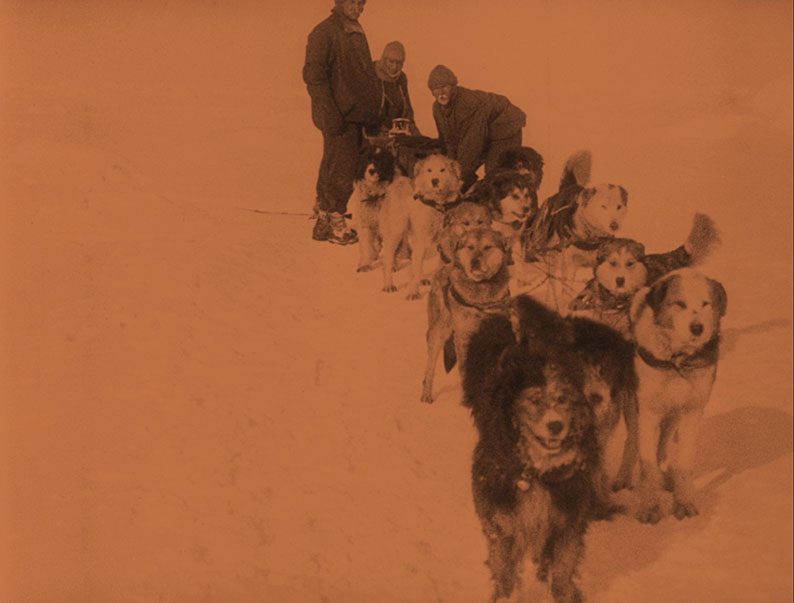
The soundtrack is Neil Brand's score, or rather two of them: his original score from 2002 with himself on piano and two iterations of his new score written for wind, strings and brass and played by the Covent Garden Sinfonia. This was orchestrated by and is conducted by Ben Palmer and played by Simon Gilliver (flute, piccolo), David Campbell (clarinet, bass clarinet), Kira Docherty (horn), Francesca Barritt (violin), Matthew Kettle (viola) and Alexander Rolton (cello). The new score is available in LPCM 2.0 and DTS-HD MA 5.1. There's not much difference between the two tracks, though the 5.1 version is mixed slightly quieter and even with the .1 there's not much in the low end. The scores on the other films are LPCM 2.0, library music used other than on The Home of the Blizzard, which is mute. The intertitles for South are in English, but optional subtitles are available for the other films which are intertitled in other languages, and for the two narrated items and the recordings of Shackleton's voice.
(As mentioned above, while I, and the disc's title, prioritise South, the films on this disc are arranged on the menu by expedition and in chronological order. My comments will follow that order, and then go to the two items which are on the menu as extras.)
The British Antarctic Southern Cross Expedition (1898-1900)
Antarctic Expedition: Sir George Newnes's Farewell to Officers and Crew (0:52)
The oldest expedition represented in this set was led by Carsten Borchgrevink, who in 1895 had become the first man proven to have set foot in Antarctica. He found a backer for a further expedition in Sir George Newnes. While a cine camera was taken on the voyage, no film was shot – not unlikely that the camera was not up to the task as at such low temperatures lubricant froze and film jammed in the camera. So all we have is this short film of Newnes wishing the expedition on its way, shot in 68mm, one of several experiments with large-format filming in Britain at the very end of the nineteenth century and the start of the twentieth (which would be a Blu-ray release I'd very much welcome).
British Antarctic Nimrod Expedition 1907-1909
Departure of Shackleton's British Antarctic Expedition from Lyttleton, New Zealand, 1908 (8:01)
Shackleton had been on the crew of Robert Scott's 1903 expedition but had left it early due to being unwell. He kept himself busy, becoming the secretary of the Royal Scottish Geographical Society and marrying Emily Dorman, both in 1904. In 1906 he stood for Parliament in the General Election, as the Liberal Unionist candidate in Dundee, but he was unsuccessful. But his heart was set on returning to the Antarctic with his own expedition, and so it came to pass. Film was shot on the expedition but none is known to survive, though there is rumours that one shot exists amongst the Japanese footage (see below). Eric Marshall was the cameraman and reviews of the time suggest that his work was not up to the later achievements of Ponting and Hurley.
What does survive, though are these eight minutes of the Nimrod departing Lyttleton, shot by James McDonald for the New Zealand Tourist Board, with a large crowd there to see it off. The film is particularly grainy and heavily scratched, but as ever with material of this vintage, let's be grateful it survives at all. The film is black and white, but the intertitles are tinted red.
My South Polar Expedition (3:43)
Shackleton gives his own account of the expedition, recorded on to a wax cylinder (with plenty of crackle) in 1910. This plays as a second audio track over the footage of the departure from Lyttleton, and it finishes with a brief vocal noise, possibly from someone else present at the recording. After that, the track returns to the music score for the rest of the running time. Sound recording of this nature was newish technology, and as with other recordings from this period there's a sense of formality to it: it was not a device for recording casual conversation, though that would no doubt be fascinating to listen to if such things existed. Shackleton clearly thinks this is a significant testament on his part, signing off with the date he recorded this: "I, Ernest Shackleton, have today, March the thirtieth, dictated this record."
Shackleton Speaks (0:53)
More of the man himself via a vintage sound recording, also from 1910, in which he names his crew.
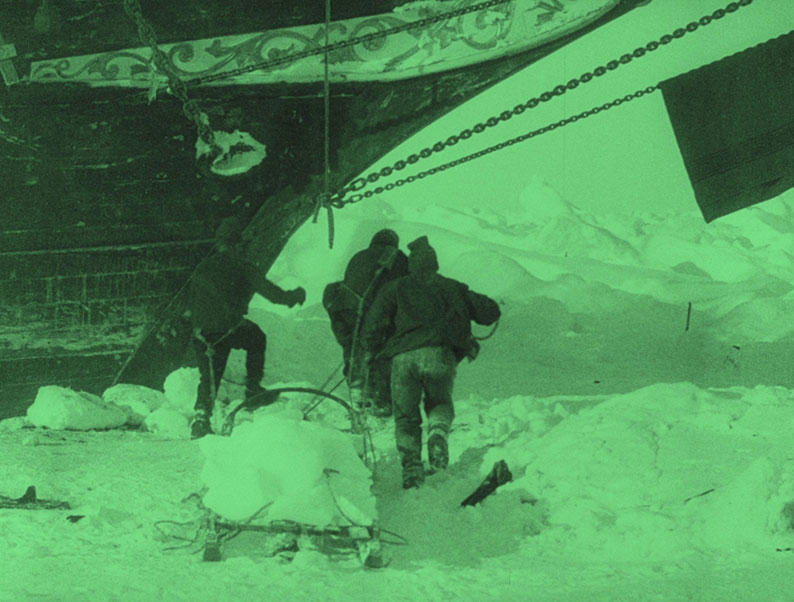
Japanese Expedition to Antarctica 1910-1912
Nihon hankyu tanken (The Japanese Expedition to Antarctica) (18:55)
These is Japan's earliest surviving documentary feature, shot on 35mm film. It survives in a forty-seven-minute version, newly digitally restored (the restoration premiered in 2019). That was presumably unavailable for this release so we have this cut-down nineteen-minute version derived from a 16mm print and, to be frank, it's in the worst condition of the films in this set. As a feature-length film it was premiered in 1912 with Nobu Shirase, the expedition leader, giving a live commentary. The footage was shot by Yasunao Taizumi and the intertitles are in Japanese, with English subtitles available.
Shirase had had ambitions to explore the Poles for some time. He had intentions on reaching the North Pole, but the success of Robert Peary's expedition there in 1909 (though nowadays considered not to actually have reached the Pole though come close to it) meant that he switched his attentions to the South. Shirase's expedition reached a latitude of 80°S and became the first men to land on the coast of King Edward VII Land.
Roald Amundsen's South Pole Expedition 1910-1912
Fram's South Polar Expedition (21:31)
By contrast, this item looks astonishingly good and rivals the main feature, thanks to its digital restoration in 2008. It was clearly intended for an international audience as silent films could be – you just had to change the intertitles accordingly, and here we have them in English. The film is windowboxed (black bars on all four sides) and the frames have properly vintage rounded corners.
With all the emphasis on the heroic failure of Scott's simultaneous expedition, it's good to have some emphasis on Scott's rival and his story of Norwegian triumph. About thirty minutes of film exists from this voyage. As with South, it was originally used as an accompaniment to Amundsen's lectures and some of it also appeared as still photographs in Amundsen's book The South Pole. The film was then re-edited for cinema showings. The present version is based on an English-language nitrate print (German and Norwegian versions also exist). The film, and still photographs, were developed on board Amundsen's ship the Fram. The footage was shot by the crew members, including Amundsen, rather than by professional cinematographers like Hurley and Ponting. The camera was not taken on the final push to the Pole, so there is no footage of Amundsen and his crewmembers there, though still photographs were taken. The film also prefigures South and other films with its emphasis on wildlife footage, clearly a selling point to cinema audiences a century ago and indeed still the case now.
The Australasian Antarctic Expedition 1911-1914
Home of the Blizzard (68:25)
Given their location, Australia and New Zealand were frequent starting-off points for Antarctic expeditions. In fact the first such explorations of Australian interest were made by Norwegian immigrant to the country Carsten Borchgrevink. The Expedition of 1911-1914 was much larger affair, captained by Douglas Mawson. With the Pole having been conquered during the preparation for this expedition, Mawson and his crew concentrated on the less-known Adelie Land, due south of Australia. Setting out in December 1911, by the beginning of the following year they had established a camp on Cape Denison (the "home of the blizzard" of the film title, well-named due to its 200km/h winds).
The film is made up of footage shot by Frank Hurley, augmented by others shot by another cameraman, Richard Primmer, as not all of Hurley's footage was usable. A version of the film was shown in Australian cinemas in May 1912, with a longer version released in July the following year. Hurley shot new footage in 1913 while on the journey to relieve Mawson and his crew. In 1914, with Hurley on Shackleton's expedition, Mawson had reacquired all rights to the film and used it in his lecture tours. The film was given a commercial release in March 1915 in the USA (coincidentally in the same week that The Birth of a Nation was released) and in a shorter version in London in April the same year, under the present title of The Home of the Blizzard. Hurley gave lectures in Sydney in November 1919 to a version of the film called In the Grip of the Polar Pack-Ice. The film is the oldest fully-surviving Australian feature.
The transfer on this disc is the longest-known version, but is less than the versions shown just over a hundred years ago. That version had sequences tinted and toned in various colours, while the present transfer is entirely in black and white. There are also no intertitles: in 1916 Mawson was offering the film to distributors to recut and title as they saw fit, though the present version is almost identical to the one then, going by a contemporary shot list. The transfer is also mute, no doubt due to library music not being available for just over an hour and the cost of commissioning a new score. So you can provide your own music as you watch, or not entirely comfortably watch in silence.
Extract from Pathé Animated Gazette No. 140 (0:45)
As again it's the wildlife which is the show, here the expedition dogs on board ship with their handlers.
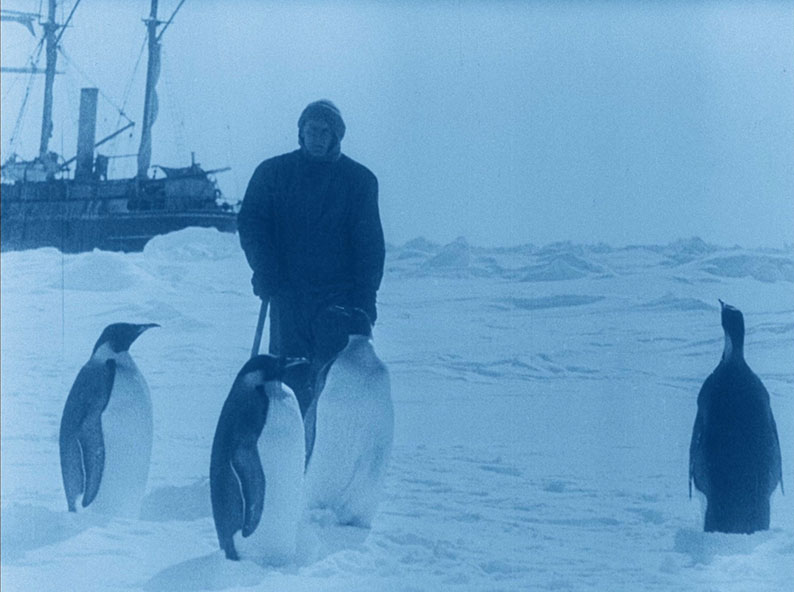
The Imperial Trans-Antarctic Expedition 1914-1917
Additional Footage from South (18:31)
South begins with studio-shot close-ups of some of the participants, introduced by intertitles, before we see them depart from Buenos Aires (shot by a local cameraman). Also included, in named subsections, is footage of the Endurance stuck in the ice, and some shots of the huge glacier Shackleton and his men had to scale on the uninhabited south side of South Georgia, Shackleton rescuing his men on the fourth attempt, and the ship's landfall at Valparaiso, Chile, greeted by a huge crowd. As deleted scenes go, these are quite something.
Dogs for the Antarctic (1:02 and 0:46)
These are extracts from two different newsreels taken just before the expedition's departure, the first respectively from Topical Budget, the second from Pathé, showing the dogs in quarantine at Beddington. Clearly it wasn't so much the prospect of brave exploration at the end of the earth which was the selling point here, but the four-legged members of the crew.
Captain Davis Returns to Sydney After an Adventurous Voyage to the Antarctic Regions to Rescue Part of the Shackleton Expedition (0:26)
Another newsreel extract, this time from the Australasian Gazette.
Ross Sea Party (8:42)
Shot in January 1917 by Aubrey Howard Ninnis, the Aurora's purser, and Alexander Stevens, the chief scientist. This is raw footage, as there it was never commercially released with no notes as to how it would be assembled. Instead of a music score, there is an optional commentary by Kelly Tyler-Lewis, which fills in the detail about this part of the expedition which isn't available elsewhere on this release. It's a dramatic story, but after the men returned home their story was overshadowed by the story of the loss of the Endurance and the heroic rescue of those men, and the fact that a World War was in progress.
The Shackleton-Rowett Expedition 1921-1922
After he returned home, Shackleton served out the War in Northern Russia, but with the Armistice he gave lectures on the Endurance expedition to large crowds, at some points daily. Shackleton had ambitions for another Polar expedition, this time north to the Beaufort Sea in the Canadian Arctic. However, this fell through and so once again Shackleton headed south on a voyage funded by his old schoolfriend John Quiller Rowett. The expedition, on the Quest, was intended to survey Enderby Land and parts of the Weddell Sea. However, it was to be Shackleton's last voyage as, on 5 January 1922 at the whaling station of Grytviken on South Georgia, he suffered a fatal heart attack. He was forty-seven years old. The expedition continued under the command of Frank Wild, who had been with Shackleton on the Endurance. In accordance with Lady Shackleton's wishes, Shackleton was buried in the whalers' graveyard in Grytviken. On their return from Antarctica, the crew of the Quest erected a memorial to him there. And with that the Heroic Age of Antarctic Exploration came to an end.
The Late Sir Ernest Shackleton Bathing Query (2:09)
The ambiguous title is explained by Query being a dog, in this extract from the 1922 documentary film Southward on the Quest. This film, sixty-eight minutes long, is not included on this disc, but you can watch the whole thing on BFI Player for free here. Clearly the appeal of canine explorers was unabated. The film was shot by JC Bee-Mason until he succumbed to seasickness, after which George Hubert Wilkins took over.
El hominaje del Uruguay a los restos de Sir Ernest Shackleton (11:04)
This is footage, shot by local cameramen, of Shackleton's body lying in state in Montevideo before leaving for burial in South Georgia. This item has Spanish intertitles, translated by optional English subtitles.
Shackleton's Funeral (4:06)
Another extract from Southward on the Quest, showing members of the expedition visiting Shackleton's grave and erecting their monument.
Shackleton South Georgia Birds (12:54)
Shot by George Hubert Wilkins, this is footage taken during the expedition, again recording the local wildlife of the island.
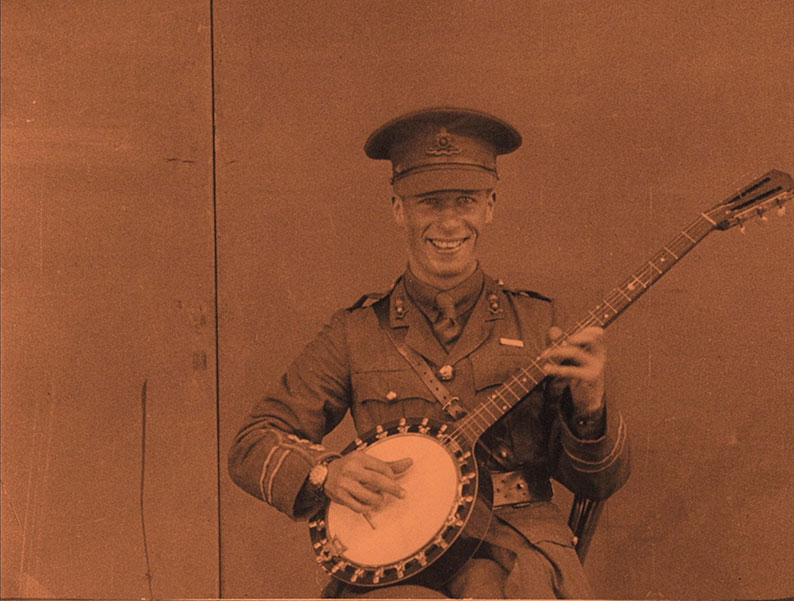
And on to the two items in the Extras menu…
Map of the Imperial Trans-Antarctic Expedition (1:40)
Produced for the previous 2002 DVD release of South, this animated map with a commentary by Kelly Tyler-Lewis, giving a brief but useful overview of the plan for the expedition.
Scoring South (15:40)
In a newly-produced item for this release, Neil Brand talks about his scores for South, his original piano-based one from 2002 and his new score performed by the Covent Garden Sinfonia, with footage of them at work recording. For those interested in how composers work in the twenty-first century, Brand shows us himself at work at his computer, running Cubase software on one monitor with the film itself playing on another.
Booklet
The BFI's booklet, available in the first pressing only, runs to thirty-six pages between the covers. As is often the case with the BFI's documentary releases, if you do have any interest in the subject do ensure you buy a copy from that first pressing as there is plenty of information here that isn't on the disc itself. The main essay is by Bryony Dixon, who begins with quotes from John F. Kennedy committing the USA to landing men on the Moon by the end of the 1960s and from the Sixth International Geographical Congress of 1895, urging a commitment to Antarctic exploration, then the greatest unexplored space on the planet, by the end of the nineteenth century. Dixon points out that the Heroic Age of Antarctic Exploration coincides with the rise of cinema as a medium and how the two went hand in hand, with sales of film rights becoming a not insignificant part of expedition funding. The essay gives us an overview of the period of exploration, including the lesser-known expeditions such as the Australasian and Japanese ones, and this release gives us as much of the surviving footage as possible in one release.
There then follow essays on each voyage, detailing the events and also discussing the films shot on them: Dixon again on the Southern Cross expedition, Naomi Boneham and Charlotte Connelly on Nimrod, Masaki Daibo on the Japanese expedition, Eirik Frisvold Hanssen on the Amundsen expedition, Quentin Turnour on the Australasian expedition, Dixon on the Imperial Transatlantic Expedition and South, Boneham and Connelly on the Shackleton-Rowett expedition. In addition there are credits for the films and the extras – not notes, as much of the detail is covered in the essays anyway – and stills.
The Heroic Age of Antarctic Exploration lasted just over a quarter of the century, from the last years of the 1890s up to Shackleton's death in 1922. The last great uncharted wilderness on Earth was explored and the new-fangled technology of moving pictures were there for the most part to record what they found. Some of the footage is still astonishing, especially if you're lucky enough to see it on a big screen, as many of the 1910s and 1920s did, and all of it is of historic significance. This is a fine release from the BFI.
|